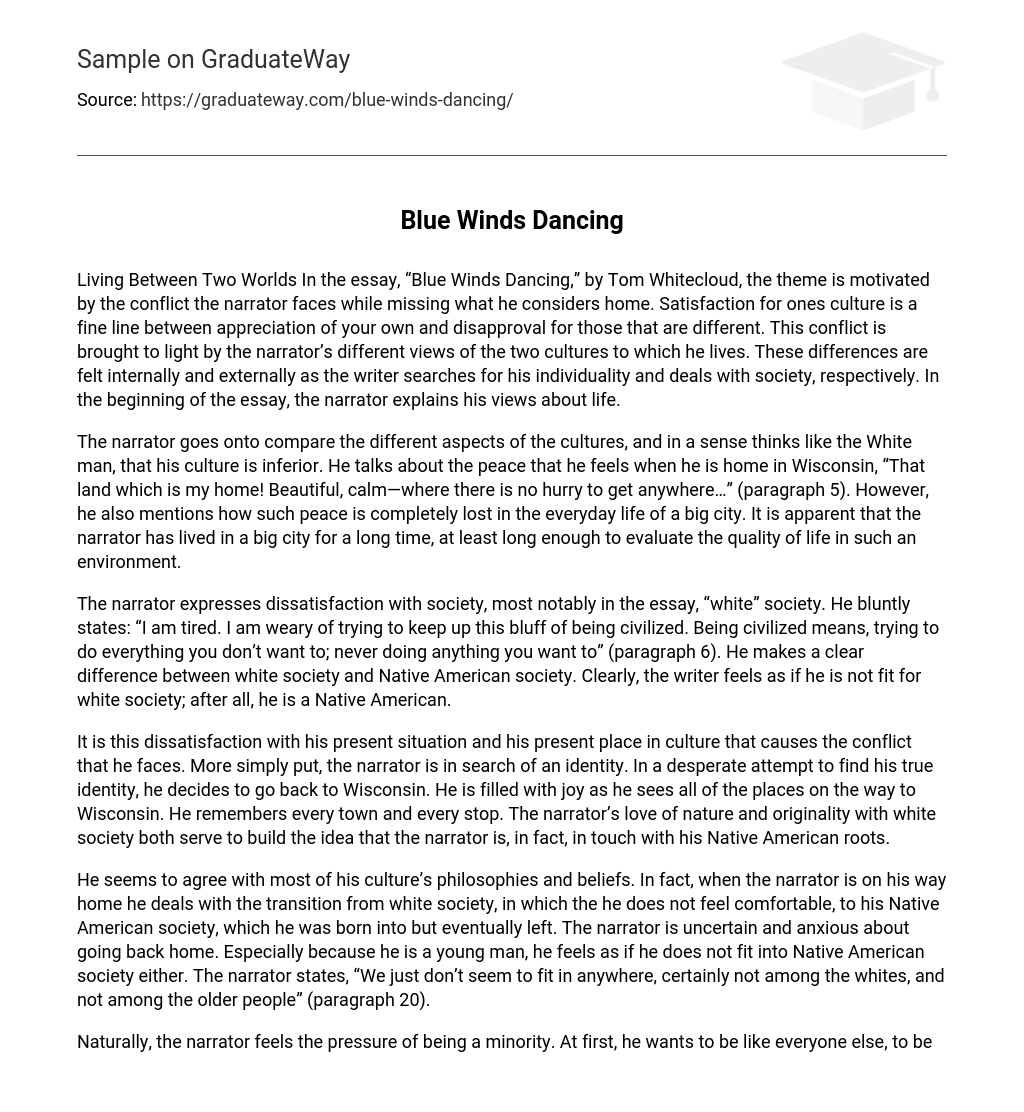The essay “Blue Winds Dancing” by Tom Whitecloud explores the theme of living between two worlds and the conflict that arises from longing for one’s home. The narrator grapples with finding satisfaction in their own culture while simultaneously disapproving of others. This conflict is evident in the narrator’s contrasting views of the two cultures they inhabit. These differences are experienced both internally and externally, as the writer searches for their individuality and navigates society. The essay begins with the narrator sharing their perspective on life.
The narrator examines and assesses different cultural aspects, making parallels with the mindset of the White man and suggesting a feeling of inferiority in his own culture. He shares the peaceful sensation he feels in his birthplace, Wisconsin, portraying it as “Beautiful, calm—where there is no rush to reach a destination…”. However, he also recognizes that this serenity is completely absent in the fast-paced way of life found in a big city. It is evident that the narrator has spent considerable time residing in such an urban setting, giving him the ability to make informed evaluations about its standard of living.
The essay openly expresses the narrator’s discontent with society, particularly “white” society. The narrator openly admits to feeling exhausted and frustrated from attempting to conform to societal expectations, which he defines as constantly engaging in unwanted actions and never pursuing his true desires. Moreover, the narrator highlights the contrasting characteristics between white society and Native American society, indicating a sense of disconnection from white society based on their Native American heritage.
The narrator’s conflict arises from his discontentment with his present circumstances and societal standing, essentially a quest for self-identity. To discover his true sense of self, he chooses to go back to Wisconsin. The sight of each location encountered during the journey brings him joy as he recollects every town and stop. Through his affinity for nature and adeptness in navigating both Native American and white communities, the narrator demonstrates a strong connection to his Native American heritage.
Despite feeling uncomfortable in white society, the narrator agrees with most of his culture’s philosophies and beliefs. However, when he transitions back to his Native American society, which he was born into but left, he is uncertain and anxious. As a young man, he feels that he doesn’t fit in anywhere – not among the whites and not among the older people in his Native American society. The narrator states, “We just don’t seem to fit in anywhere, certainly not among the whites, and not among the older people”.
Naturally, the narrator experiences the weight of being a minority. Initially, he desires to assimilate into white society and be similar to others. Subsequently, he grasps that this society does not meet his expectations. Consequently, he longs to reunite with his family, now recognizing their importance. However, the narrator fears the judgments of his father and society, particularly since he had previously abandoned them for white society. Nonetheless, both his father and society accept him as if nothing had occurred.
Upon arriving in Wisconsin, the narrator is greeted with the phrase “Be happy! You are home—you are free. You are among friends—we, the trees, and the snow, and the lights”. Through his interactions with white society, he develops a newfound respect for his own culture. Ultimately, without any external guidance or instruction, he acknowledges that he is truly a Native American. He wholeheartedly embraces his heritage and declares “I am happy. It is beautiful. I am home.”.
The narrator experiences a moral reconciliation as he reconnects with his roots and reconciles them with his upcoming new life. This leads to both internal conflict regarding his lack of identity and external conflict with society. Despite these fears, the narrator decides to return home and regain his true identity that was lost when he left. By embracing his Native American heritage, the narrator fulfills the purpose of his journey and resolves the longstanding conflict tearing him apart.





